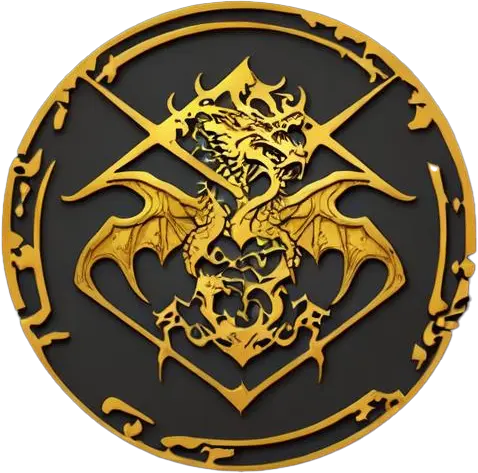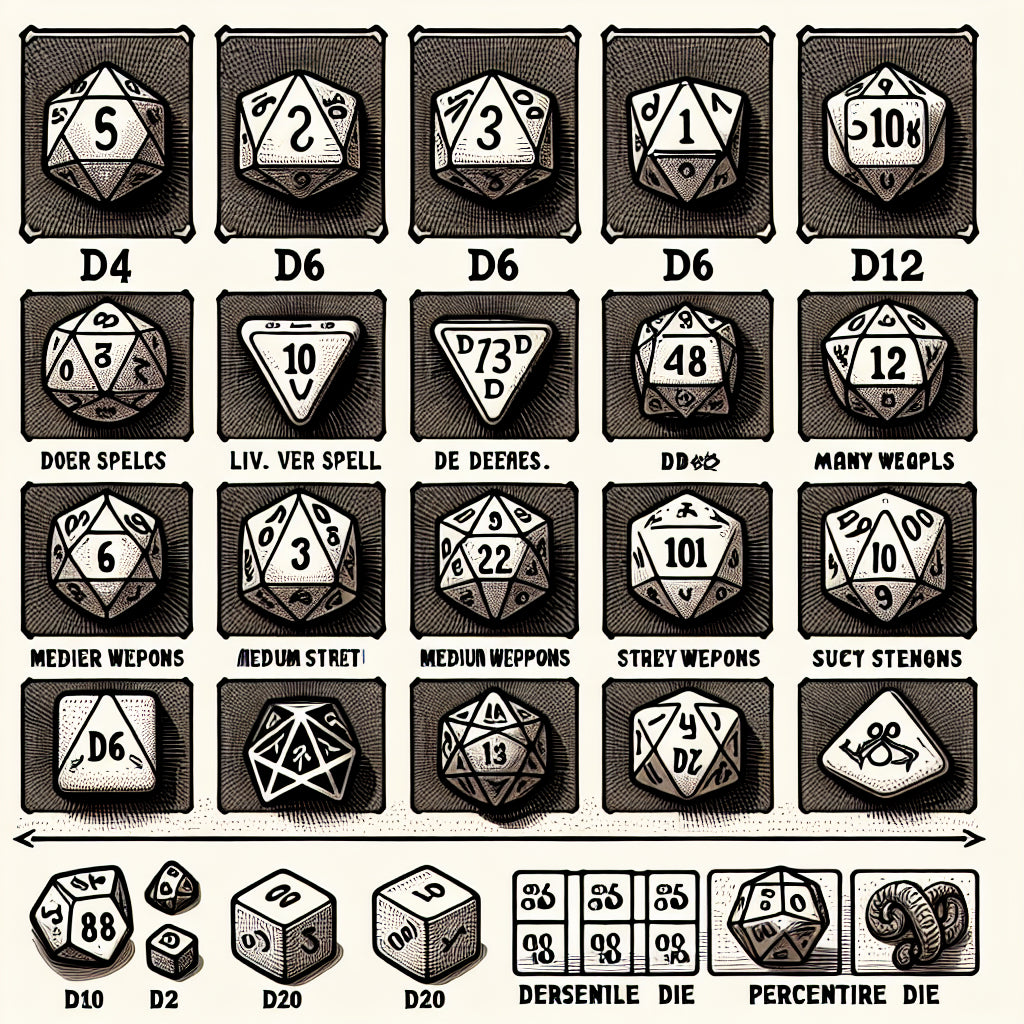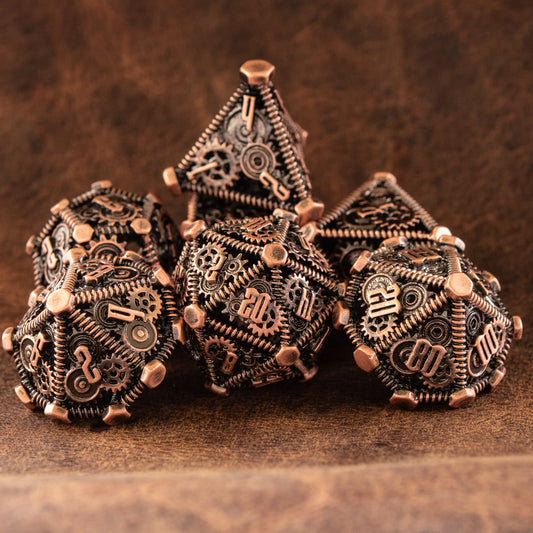D&D Dice and What They Do: A Comprehensive Guide
Introduction
In the world of Dungeons & Dragons (D&D), dice play a pivotal role in shaping the gameplay experience. These multi-sided polyhedral dice are not just tools for randomization; they are the very essence of the game, determining the outcomes of your character's actions, successes, and failures. From the smallest spell to the most epic battle, dice rolls add an element of chance and excitement that keeps players engaged and on their toes. In this guide, we will delve into the intricacies of D&D dice, exploring their roles, mechanics, and how they enhance the overall gameplay experience.
Understanding D&D Dice
Dice Shapes and Names
D&D dice come in various shapes, each with a specific number of sides and a unique role in the game. Here's a quick rundown of the shapes and names of each type of dice:
- d4 (Tetrahedron): Four-sided die
- d6 (Hexahedron): Six-sided die
- d8 (Octahedron): Eight-sided die
- d10 (Pentagonal Trapezohedron): Ten-sided die
- d12 (Dodecahedron): Twelve-sided die
- d20 (Icosahedron): Twenty-sided die
- Percentile Dice: Two ten-sided dice used together to generate a number between 1 and 100
Overview of D&D Dice
A standard D&D dice set includes seven dice: d4, d6, d8, d10, d12, d20, and percentile dice. Each of these dice serves a different purpose in the game, from determining damage in combat to resolving skill checks and saving throws.
How Dice Rolls Work in D&D
Basic Mechanics
At the core of D&D gameplay are dice rolls. When a player attempts an action that involves an element of chance, they roll the appropriate dice and add any relevant modifiers or bonuses. The result is then compared to a target number, known as the Difficulty Class (DC), to determine success or failure. Modifiers can come from a character's abilities, skills, or equipment, adding depth and strategy to the game.
Combat Rolls
Combat in D&D is a dynamic and thrilling aspect of the game, driven by a series of dice rolls:
- Attack Rolls: When a character attacks, they roll a d20 and add their attack bonus. If the result meets or exceeds the target's Armor Class (AC), the attack hits.
- Damage Rolls: Once an attack hits, damage is determined by rolling the appropriate dice for the weapon or spell used. For example, a longsword might deal 1d8 damage.
- Saving Throws: These rolls determine whether a character can resist or avoid harmful effects. Players roll a d20 and add the relevant ability modifier (e.g., Dexterity for dodging a fireball). If the result meets or exceeds the DC, the saving throw is successful.
Skill Checks
Skill checks are used to determine how well a character performs tasks outside of combat, such as picking locks, climbing walls, or persuading NPCs. Players roll a d20 and add their skill modifier. The result is compared to the DC set by the Dungeon Master (DM) to determine success or failure.
The Role of Each Dice in D&D
d20 - The Decider
The d20 is the most iconic and frequently used die in D&D. It is primarily used for:
- Attack Rolls: Determining whether an attack hits.
- Skill Checks: Evaluating the success of non-combat actions.
- Saving Throws: Resisting spells and other harmful effects.
d12 - The Heavy Hitter
The d12 is often reserved for the most powerful attacks and spells, making it a critical die for high-damage scenarios:
- Damage Rolls: Used for heavy weapons like greataxes and powerful spells.
d10 - The Versatile Die
The d10 serves multiple purposes in D&D, making it a versatile tool in a player's arsenal:
- Damage Rolls: Commonly used for medium to high-damage weapons and spells.
- Percentile Rolls: When paired with another d10, it generates a number between 1 and 100, useful for random events and loot tables.
d8 - The Balanced Die
The d8 strikes a balance between power and frequency of use:
- Damage Rolls: Often used for one-handed weapons like longswords and spells.
d6 - The Familiar Die
The d6 is one of the most recognizable dice, used extensively in various aspects of the game:
- Damage Rolls: Common for many weapons and spells.
- Character Stats: Often rolled during character creation to determine attributes.
d4 - The Small but Mighty Die
Though it has the fewest sides, the d4 plays a crucial role in D&D:
- Damage Rolls: Used for small weapons like daggers and certain spells.
By understanding the roles and mechanics of each dice, players can better strategize and enhance their D&D gameplay experience. Whether you're rolling a d20 to land a critical hit or a d4 to cast a spell, each dice adds its own flavor of excitement and unpredictability to the game.
D&D Dice and What They Do: A Comprehensive Guide
Choosing the Right D&D Dice Set
Quantity of Dice
When it comes to Dungeons & Dragons (D&D), having the right number of dice is crucial for smooth gameplay. Both players and Dungeon Masters (DMs) should consider having multiple sets to ensure they are well-prepared for any situation.
- Players: A single set of seven dice (d4, d6, d8, d10, d12, d20, and percentile dice) is the minimum requirement. However, having two or three sets can be beneficial, especially for characters who use multiple dice for damage rolls or spells. For example, a rogue might need several d6 dice for sneak attack damage.
- Dungeon Masters: DMs should have at least three to five sets of dice. This allows them to roll for multiple non-player characters (NPCs) simultaneously and handle various in-game scenarios without delay. Additionally, having extra dice on hand can help accommodate players who might forget their own sets.
Types of Dice Sets
Dice sets come in various materials, each offering a unique feel and aesthetic. Here are some popular options:
- Plastic Dice: These are the most common and affordable. They come in a wide range of colors and designs, making them a great choice for beginners and seasoned players alike.
- Metal Dice: Known for their weight and durability, metal dice offer a satisfying heft and a premium feel. They are perfect for players who want a more substantial and tactile rolling experience.
- Gemstone Dice: These are made from real gemstones and offer a luxurious and visually stunning option. While they can be more delicate and expensive, they add a touch of elegance to any game.
Dice Accessories and Care
Dice Trays and Bags
Using dice trays and bags is essential for keeping your dice organized and protected.
- Dice Trays: These provide a designated area for rolling dice, preventing them from scattering across the table. They also protect your dice and playing surface from damage. Dice trays come in various materials, including leather, wood, and fabric, catering to different preferences.
- Dice Bags: Dice bags are perfect for storing and transporting your dice. They come in various sizes and materials, from simple cloth pouches to elaborate embroidered bags. A good dice bag will keep your dice safe and easily accessible.
Proper Storage and Maintenance
Proper care and storage of your dice can ensure they last for years to come. Here are some tips:
- Clean Hands: Always handle your dice with clean hands to prevent oils and dirt from accumulating on them.
- Storage: Store your dice in a soft, padded container to protect them from scratches and damage. Separate compartments or individual bags for different types of dice can help keep them organized.
- Rolling Surface: Use a dice tray or a soft surface to roll your dice, as hard or rough surfaces can cause chips and scratches.
- Regular Inspection: Periodically check your dice for any signs of wear and tear. Replace any damaged dice to maintain fair gameplay.
The Role of Each Dice in D&D (Continued)
d4 - The Small but Mighty Die
The d4, or four-sided die, is often used for determining damage from small weapons and spells. Despite its small size, it plays a crucial role in the game:
- Damage Rolls: Commonly used for weapons like daggers and spells such as Magic Missile.
- Healing Spells: Often used in healing spells like Cure Wounds, where the amount healed is determined by rolling one or more d4 dice.
d6 - The Familiar Die
The d6, or six-sided die, is one of the most versatile dice in D&D:
- Damage Rolls: Frequently used for many weapons, including short swords and light crossbows.
- Character Stats: Rolled during character creation to determine attributes. The standard method involves rolling 4d6 and discarding the lowest roll to generate each stat.
- Spells: Used in various spells, such as Fireball and Lightning Bolt, where multiple d6 dice determine the damage.
d8 - The Balanced Die
The d8, or eight-sided die, strikes a balance between power and versatility:
- Damage Rolls: Often used for one-handed weapons like longswords and battleaxes.
- Spells: Utilized in spells like Divine Smite, where the damage is determined by rolling one or more d8 dice.
Conclusion
Dice are the heartbeat of Dungeons & Dragons, bringing an element of chance and excitement to every game. Understanding the role of each die, choosing the right dice set, and properly caring for your dice can significantly enhance your gameplay experience. Whether you're a player or a Dungeon Master, investing in quality dice and accessories is a step towards more immersive and enjoyable adventures.
Explore different dice sets and accessories to find what suits your style and needs best. With the right tools at your disposal, you can dive into the world of D&D with confidence and enthusiasm. Happy rolling!






